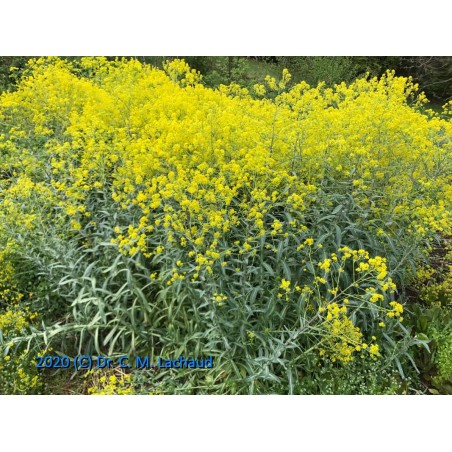












-
Isatis tinctoria is a fast-growing biennial plant, which thrives on dry soils, wasteland, stony grounds, etc. in open exposure and full sun
Seeds germinate in spring of Year 1, and quickly establish a taproot and a rosette of smooth, broad, brittle, and bright green leaves
Flowering takes place in the spring of Year 2
Very early in March, flower stalks emerge from the rosette of leaves
They are dressed in elongated, small, leathery, and glaucous green leaves, arranged in helix around the stem
The blooming is spectacular
Flowers are small, very abundant, and gathered in majestic panicles of 1.5m
They each have 4 green sepals and 4 bright yellow petals, the combination of the two colors giving the panicle a very fresh color, which contrasts beautifully with the bluish foliage
They are meliferous and very attractive to bees
An abundance of fruits (siliques), green then brown, appear a few weeks later
Siliques, containing seeds, are suspended gracefully over the entire panicle and give it a very decorative aspect
WARNING !
Plant known to be invasive in some regions, control its spread by preventing it from producing seeds
The seeds give an edible oil similar to rapeseed oil
Isatis tinctoria has some medicinal properties: Antibacterial, Antiviral, Astringent, Anticancer, Emetic, and Laxative
It was traditionally used in the Caucasus countries as a leaf decoction to treat wounds, tumors, boils, and fungal dermatitis, or as a syrup against measles
Isatis tinctoria is a dye plant, traditionally used to produce Indigo
In Western Europe, Dyer's Woad was cultivated on a large scale and since the Middle Ages, both as a source of Blue Pigment and for textile dyeing
It was long known for the latter use, by the Celtic populations of northern Europe, as well as by the Romans and other Peoples of the Empire
It is also possible to get a purple dye, caused by Indirubine
Hardy, Woad will grow in regions with a cold winter, contrary to other indigoferous plants, from tropical and subtropical climates
-
| Jan | Feb | Mar | Apr | May | Jun | Jul | Aug | Sep | Oct | Nov | Dec | ||
|---|---|---|---|---|---|---|---|---|---|---|---|---|---|
| A1 | |||||||||||||
Sow the seeds of Isatis tinctoria at the very beginning of spring, directly in place, by dispersing the siliques in a fairly spaced manner (large plants) on a clean, loosened soil.
Bury them slightly by scratching the surface of the soil with a rake
For extracting Indigotine, harvest the leaves in June and July on Year 1
This is when you will get the highest Indigotine content, and the best indigo quality
There are several methods for subsequently obtaining the indigo color in dyeing
-
Learn to Use this Indigo Plant with our Courses:
You might also like
Payment :
PayPal < 150 €
Check < 850 €
Bank Wire > 149 €
Thank you for your kind understanding